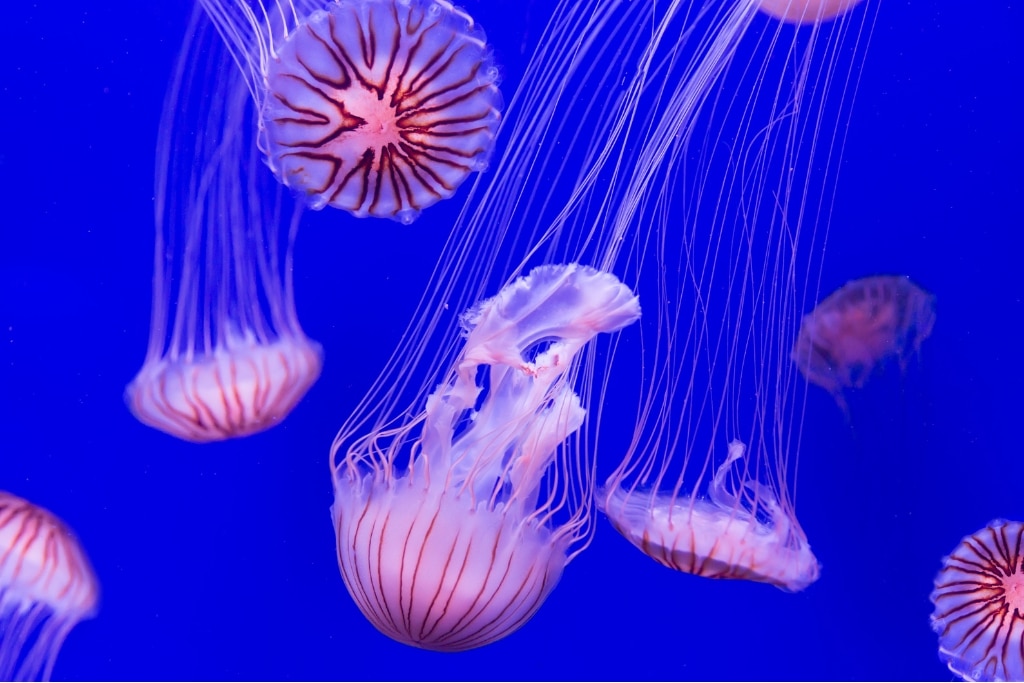November 3rd is globally recognized as World Jellyfish Day, a day to highlight and celebrate the brainless beauties that have been floating around our oceans for millions of years. First acknowledged in 2014, this day also focuses on education and conservation efforts for jellyfish. Learn more about this invertebrate, what makes it so unique in marine ecosystems, and how you can help to protect both sea jellies, and our oceans, against the many challenges they face.
—
Belonging to the scientific class Scyphozoa under the phylum Cnidaria, which also includes coral and sea anemones, jellyfish are composed of more than 200 species and can be found in all five oceans on Earth.
Jellyfish have been around for between 500 to 700 million years, making them the oldest multi-organ animal. Their role in marine ecosystems is extremely important, as they are vastly considered keystone species in most oceanic food webs.
Quite ironically, jellyfish are not actually fish – fish anatomy origins around their spines, while jellyfish do not have a spine, gills, a brain, bones, or even blood.
A Closer Look at Their Unique Design
Their anatomy is focused on radial symmetry, with body parts radiation from a central axis. This allows these invertebrates to detect food and danger from any direction.
Having no brain, they sense the world around them by detecting light and gravity using their sensory structures called rhopalia, resembling a “nerve net” located at the end of their heads. Their tentacles, varying in size depending on the species, are able to sting their prey or enemies.
The sting comes from their nematocysts: by brushing up against their food or an object, these cells burst out a tiny barb, injecting the prey with venom.
The tingly feeling after being stung by a jellyfish is the result of these tiny barbs in human skin, though the severity of the sting itself can vary greatly.
Most of the toxins they release are non-dangerous to humans, with pain typically resembling a wasp sting, with a few exceptions like the box jelly or Man of War. These jellies can kill you if barbed enough.

The largest recorded species of jelly is the lion’s mane jellyfish, with tentacles that can flow more than 100 feet (30.48 meters) long and a head more than eight feet in diameter. Surprisingly, this species is not poisonous to humans, but their sting can still be extremely painful.
Jellyfish also use colloblasts – sticky cells located on their tentacles – to capture prey, which they then transport to their mouths for digestion.
With around 95% of their body made of water, they are overall pretty simple creatures. They have a simple digestive system that includes a stomach and intestine, with a single opening serving as both the mouth and the anus.
Their main diet consists of plankton, small marine organisms. Jellyfish also dine on miniature shrimp, crabs, small fish, or even other jellies.
Jellyfish have a variety of natural predators, including many species of fish such as mackerel, salmon, dogfish and sunfish, turtles, crabs and other crustaceans and even seabirds such as seagulls.
The Role of Jellyfish in Marine Ecosystems
Many fish species interact with jellyfish in a mutualistic relationship, swimming among their tentacles for protection against larger predators and occasionally snacking on parasites or debris that cling to the jellyfish. These symbiotic associations help maintain balance in marine ecosystems, where shelter and protection are crucial, especially across varying water depths.
Jellyfish contribute to maintaining the marine food chain. Because they feed on smaller creatures, sea jellies are able to control populations and balance the ecosystem, even feeding on other species of jellyfish that may be smaller than them.

Jellyfish also play a crucial role in nutrient cycling in the ocean. As they drift through various water layers, they transport nutrients like nitrogen and phosphorus. These nutrients are then recycled and utilized by other marine organisms for growth and survival. Jellyfish are responsible for over 10% of nitrogen needed for growth of phytoplankton.
Beyond their role in ocean ecosystems, jellyfish have shown remarkable potential in cancer cell inhibition, early life development in microgravity, and other significant medical breakthroughs related to human space travel.
Jellyfish can metamorphose from a polyp to a swimming medusa, making them invaluable for research. This unique ability has allowed them to survive multiple mass extinctions and adapt to various ecological niches.
As a result, jellyfish are key organisms for studying ecological and evolutionary processes, as well as physiology, neuroscience, and medicinal sciences.
Riding the Waves of a Changing Ocean
Unlike other species that suffer due to climate change impacts and ocean acidification, warmer waters actually favor jellyfish growth, albeit only if they have sufficient food supply.
Another interesting trait of jellyfish is that some species do not need high oxygen levels to survive in ocean waters. While most will suffer if global warming causes a decrease in oxygen levels, some types are tolerant of very low-oxygen conditions – proving they can be the only surviving ocean animal once oxygen is used up.
“Ocean jellification” would transform a marine ecosystem dominated by fish into one dominated by jellyfish.Multiple studies have stated that jellyfish, more specifically cnidarians and ctenophores, can survive both rising water temperatures and possible overfishing impacts. However, one study by the Monterey Bay Aquarium concluded that jellyfish are threatened by microplastics and can actually serve as the “entry point” for marine microplastics into oceanic food chains.
Marine biologists around the world are comprehensively tagging jellyfish to monitor them and their patterns. This is not just to study behavioral data but also to better understand how different regions impacted by global warming may influence swarms of sea jellies.
Another major increase of population growth in jellyfish is coastal construction of harbors and ports, which provide more surface for their polyps to attach to. More surface results in more rapid reproduction. When the polyps grow bigger, they release tiny, juvenile jellies that drift with the currents.
While more research and data are needed to establish specific connections between jellyfish and climate change, current knowledge suggests that they will thrive for millions of years to come. Their ability to transform and adapt makes jellyfish nature’s resilient underwater ghosts.
This story is funded by readers like you
Our non-profit newsroom provides climate coverage free of charge and advertising. Your one-off or monthly donations play a crucial role in supporting our operations, expanding our reach, and maintaining our editorial independence.
About EO | Mission Statement | Impact & Reach | Write for us














